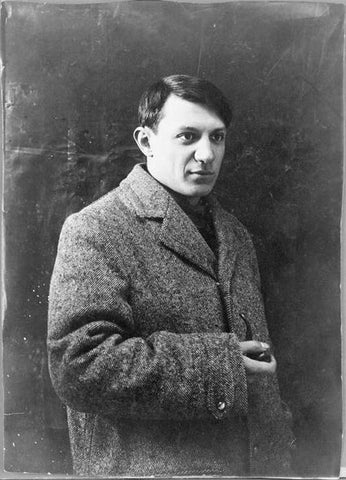M.S. Rau is committed to offering fine art of the highest caliber and we seek paintings and sculpture by historically renowned artists, often with impressive provenance. The large majority of our works of art come from private. . .
At M.S. Rau, we are committed to building a long-term, rewarding relationship with each and every client. That’s why your purchase is backed by our 125% guarantee.
Learn MoreHomme à l'agneau, mangeur de pastèque et flûtiste by Pablo Picasso
- This modern crayon drawing was created by the 20th-century master Pablo Picasso
- Composed in 1967, it was part of a playful series of drawings on the subject of Bacchus
- Rendered in just a few sparing lines, it reflects Picasso's unique artistic signature
- Get complete item description here
To speak to one of our experts, call 1-888-711-8084
1881-1973 | Spanish
Homme à l'agneau, mangeur de pastèque et flûtiste
(Man with Lamb, Watermelon Eater and Flautist)
Signed, dated and numbered “Picasso / 3.2.67 / II” (upper right)
Crayon on paper
Hailed among the fathers of modern art, Pablo Picasso possessed a seemingly endless supply of creativity that allowed him to master nearly every genre and style. Though he constantly reinvented himself as an artist, his compositions are always. . .
1881-1973 | Spanish
Homme à l'agneau, mangeur de pastèque et flûtiste
(Man with Lamb, Watermelon Eater and Flautist)
Signed, dated and numbered “Picasso / 3.2.67 / II” (upper right)
Crayon on paper
Hailed among the fathers of modern art, Pablo Picasso possessed a seemingly endless supply of creativity that allowed him to master nearly every genre and style. Though he constantly reinvented himself as an artist, his compositions are always distinctively “Picasso” with their playful lines and imaginative figures. Homme à l'agneau, mangeur de pastèque et flûtiste reflects his unique artistic signature; rendered in just a few sparing lines, his subjects nevertheless convey a myriad of themes and art historical references. It is this complexity and ingenious artistry that places Picasso among the most renowned masters in the whole of art history.
Composed in 1967, Homme à l'agneau, mangeur de pastèque et flûtiste was part of a playful series of drawings on the subject of Bacchus and bacchanalian pursuits. Here, he captures the god Bacchus himself eating a watermelon with relish; the watermelon was a favored motif of the artist, first appearing in his seminal Demoiselles d'Avignon of 1907 (Museum of Modern Art) and frequently re-appearing as a symbol for summer, heat and sensuality. Bacchus himself recalls the artistic legacy of Caravaggio, revealing the depth of Picasso's link to the Spanish Baroque tradition.
The influence of the brothers Le Nain is also felt in the work. The three brothers, who were active in Paris during the 1630s and 1640s, were renowned for their poignant images of peasants surrounded by farm animals and playing musical instruments such as the flute. Picasso is known to have owned at least one painting by the brothers, whose work he referenced frequently throughout his career.
Born in 1881 in Málaga, Spain, Picasso spent his childhood studying drawing and painting under his father, Jose Ruíz, who taught at the local art school. Picasso spent a year at the Academy of Arts in Madrid before traveling to Paris in 1900. Landing in the center of the European art world, Picasso began to mingle in the company of other artists, quickly establishing himself as a critical figure in the thriving Parisian art scene. It was around 1907 that Picasso became very influenced by African masks and art that had begun making its way into Parisian museums following the expansion of the French Empire into Africa. The faces and simplified, angular planes of the women in Picasso’s Demoiselles d’Avignon clearly derive their style from African masks and sculptures, and this painting is often heralded as the beginning of Cubism. Pushing the boundaries of his own creativity throughout his long career, Picasso devoted himself to artistic production. The result was one of the richest and most important oeuvres in art history.
This work is accompanied by a letter of authenticity signed by the artist’s son, Claude Ruiz-Picasso.
Executed on 3 February 1967
Paper: 19" high x 25" wide
Frame: 32" high x 37 3/4" wide
Provenance:
Galerie Louise Leiris, Paris
Private Collection (acquired by the above in 1968; sale: Christie's, New York, 10th May 2001, lot 149)
Sotheby's London: Thursday, June 25, 2009 [Lot 00169]
Private collection
M.S. Rau, New Orleans
References:
Charles Feld, Picasso, Dessins 27.3.66-15.3.68, Paris, 1969, no. 92 (illustrated) Christian Zervos, Pablo Picasso, Oeuvres de 1967 et 1968, Paris, 1973, vol. XXVII, no. 435 (illustrated)
The Picasso Project, Picasso's Paintings, Watercolors, Drawings and Sculpture, the Sixties II 1964-1967, San Francisco, 2002, no.67-041, (illustrated)

| Maker: | Picasso, Pablo |
| Period: | 1919-Present |
| Origin: | France |
| Type: | Drawings |
| Style: | Modernism |
| Depth: | 2.0 in. (5.08 cm) |
| Width: | 37.75 in. (95.89 cm) |
| Height: | 32.0 in. (81.28 cm) |
| Canvas Width: | 25.000 in. (63.5 cm) |
| Canvas Height: | 19.000 in. (48.26 cm) |

Picasso, Pablo
One could argue that Pablo Picasso was the most influential artist to have ever lived. He was certainly one of the most diverse, creating works of art in a dizzying array of styles and media...
Read More
10 Things You Didn't Know About Pablo Picasso
More than any other artist, Pablo Picasso defined Modern Art of the 20th century. During his lifetime, he was adored by the French public and the art establishment, reaching celebrity status in his later...
Read MoreAt M.S. Rau, we are committed to building a long-term, rewarding relationship with each and every client. That’s why your purchase is backed by our 125% guarantee.
Learn More













